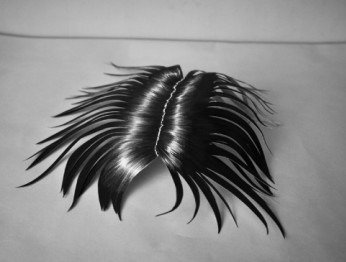Pawel Olszczynski
dal 17/3/2011 al 22/4/2011
Segnalato da
17/3/2011
Pawel Olszczynski
Zak / Branicka, Berlin
Fantome Noir. Artist's drawings are the opposite of the classic study of a model. He is occupied with surfaces and the superficiality of fashion: drapes, folds, heels, hair styles and everything that fetishizes.

French critic Nino Frank is often given credit for coining the term “film noir” to describe a group of American
crime films that were shown in French theaters in the forties. He alleged that the novelty of film noir is its shift
of the emphasis from the action to creating expressive model characters e.g.: the detective in a trench coat
or the demonic femme fatale in a satin dress with a cigarette in her hand. In his drawings Paweł Olszczyński
goes one step further—he abandons the characters and focuses on their props. These elements usually
appear alone, without "ownership"—a glove resting limply on a railing revealing that it is empty, filled only
with associations instead of a real hand, Untitled (Empty Glove). In Olszczyński’s work items of clothing
subjectively become phantoms of the body. It is his private world—a fantôme noir.
Olszczyński’s drawings therefore are the opposite of the classic study of a model. He is occupied with
surfaces and the superficiality of fashion: drapes, folds, heels, hair styles and everything that fetishizes. For
him, fashion is a language of Baudrillard's pyramidal simulacrum. It is its artificiality and its affectation what
make fashion so appealing. .
The world of fashion has long reached far into areas of art. Many designers like Rei Kawakubo, Maison
Martin Margiela or Gareth Pugh are inspired by artworks, and their collections are often more reminiscent of
collectable objects or sculptures than of actual clothing. Olszczyński asks, however, what happens if we
reverse the direction of fascination. What if art falls in love with fashion? He cites the exclusivity of the
handmade in fashion which in the art world has become too self-evident. His paper sculptures are wigs,
purses and wallets and refer to haute couture in fashion. They are as fragile and as transitory as fashion
trends.
Olszczyński seems particularly fascinated by black and the possibilities of the ordinary pencil (again, a
reference to the art-world)—sometimes deep black, soft and velvety, and at others dry, precise and thin as a
hair. He also radically juxtaposes the texture of materials like skin, fur and hair. He pulls his favorite motif—
mostly unnaturally styled hair, that evolved into fetishes—from fashion magazines. He repeatedly returns to
this motif while at the same time consciously celebrating the ritual of the obsessive, compulsive repetition,
which manifests itself in an obsessive quest for perfected execution. The process of creating drawings is
time consuming and laborious—physically and mentally exhausting. The hair on Olszczyński’s works is
tangled, dominating the entire surface of the sheet. While repetition should satisfy, it provokes anxiety and a
feeling of helplessness.
In Beyond the Pleasure Principle, Freud writes "(...) the compulsion to repeat stems from what has been
denied and has appeared in the unconscious. ... But what is the relation of the pleasure principles with the
compulsion to repeat that reveals the power of denial? It’s obvious that most of what becomes revived as a
result of forced repetition is unpleasant to our ego, as it actualizes the functions of the denied drives; it is
however distress which we have already appreciated and which does not contradict the pleasure principle, a
distress for one system, connected with a simultaneous satisfaction of another (...)"
Olszczyński’s strategy is to analyze the medium of drawing. His works are a kind of visual tautology: on a
piece of paper you see a piece of drawn paper, folded like a sheet of paper, Untitled (Sheet of Paper), or the
drawing of hair that he shapes into the likeness of hair or a wig. The artist creates objects with his drawings.
Ironically, this practice of repetition exposes the limits of mimesis. The more Olszczyński tries to convince us
that a picture is reality, the more it is impossible. As a reward, however, he reveals the natural characteristics
of the drawing medium.
Opening 18th March 2011, 6 – 9 pm
Zak / Branicka
Lindenstrasse 35 - Berlin



